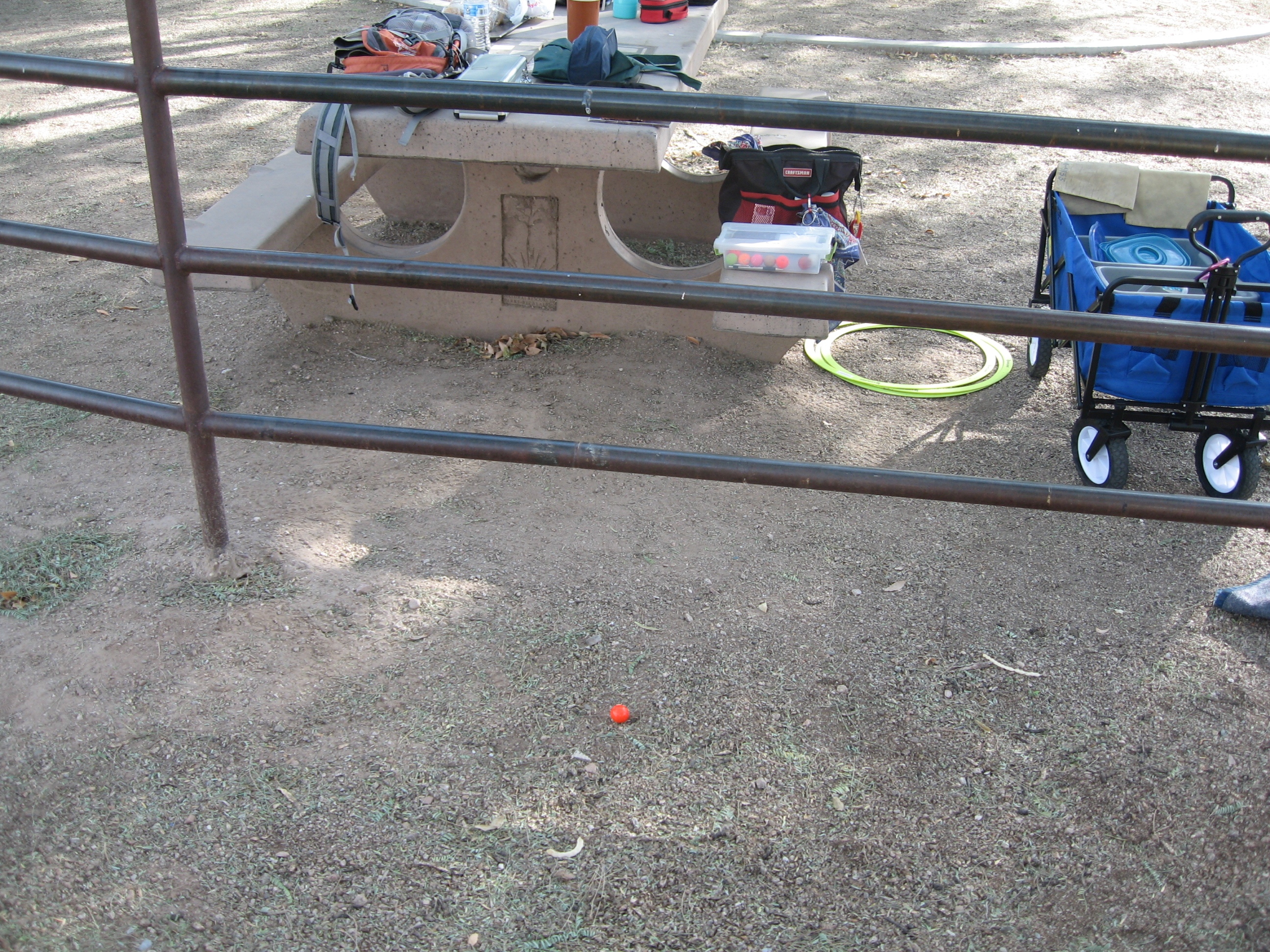[Revised 2021-04-18. The 2020 revision of the FIPJP rules reduced the minimum required distance of the thrown jack from an end dead-ball line from 1m to 0.5m. This reduced the maximum distance that you can back away from an end dead-ball line from 11m to 10.5m.]
In this post we look at the Stepping Back Rule in Article 7 and answer frequently-asked questions about it.
As we discuss the rule, we need to remember the context. The FIPJP rules are designed for FIPJP-sanctioned competitions. These competitions are typically played on rectangular lanes that are 4m wide and 15m long. Menes (ends, rounds) are played back-and-forth on these rectangular lanes, first in one direction and then in the other direction. [Note that in this essay, I use the word “former” to mean “in the previous mene”.]
Because of the limited length of the lanes, after placing the circle around the former location of the jack, players sometimes find that they can’t throw the jack to the maximum permitted distance (10m) because the circle is too close to one of the lane’s end boundary lines. The Stepping Back Rule is designed to deal with such situations.
Suppose that at the start of the first mene, the circle is placed close to the west end of the lane and the jack is thrown so that it lands exactly in the center of the lane. The lane is 15m long, so the jack is about 7.5m from each end line.

Team A wins the first mene, so it starts the second mene by placing the circle around the former location of the jack. The circle is now in the exact center of the lane.

The circle has a radius of 25cm, so one edge of the circle is 7.25 meters from the western end of the lane, and the other edge is 7.25 meters from the eastern end of the lane. In this situation, team A might like to throw the jack to 10 meters, but they cannot. Both the western and eastern ends of the lane are too close.
This is where the Stepping Back Rule comes in. Article 7 (which I’ve slightly reformatted) says—
If [and only if] there is no direction in which the jack can be thrown to the maximum distance… the player may step back, in line with the previous mene’s line of play, but without going beyond the maximum distance allowed for the throwing of the jack.
Note the “if and only if” clause. The Stepping Back Rule can be applied only if there is no direction in which it is possible to throw the jack to 10m. If there is any direction in which it is possible to throw the jack to 10m, the Stepping Back Rule cannot be used.
During a mene, the line of play is an imaginary line drawn from the circle through the jack. The former line of play is a line drawn through the circle’s current location and the circle’s former location, continuing on indefinitely in both directions. There is a place where this line crosses the end dead-ball line behind the circle’s former location— let’s call that place Q. So the player, facing the circle’s former location, steps backward along the former the line of play. While he’s stepping back, he’s looking at Q and keeping track of his distance from Q.

At any point he can stop or he can keep backing up, but if he reaches a point where he is 10.5 meters from Q, he is not allowed to back up any farther; he must stop and place the circle on the ground. Why 10.5 meters? That’s because a thrown jack must be at least half a meter (50cm) from any dead-ball line. Half a meter plus 10 meters (“the maximum distance allowed for the throwing of the jack”) gives a distance of 10.5 meters from Q. See diagram 4.

Note that invoking the Stepping Back Rule is completely optional— stepping back is permitted, but it is not required. A team doesn’t have to step back with the circle if they don’t want to. They can also move the circle only part of the maximum-allowed distance— they don’t have to move the circle the entire distance that is permitted.
Here are some frequently-asked questions about the Stepping Back Rule.
(Q1) If the former line of play crosses the lane at an angle, could a player stepping back be forced across the lane’s side boundary?
NO. You can’t place the circle outside of the lane. When “stepping back”, a player should back away from the circle’s former location (along path A in diagram 5) as long as it is possible to do so without crossing the lane boundary. Then the player should back away along the inside of the lane boundary line (along path B).

Remember that the player is backing away from the circle’s former location, but the location where he must stop is determined by his distance from Q.
(Q2) We’re playing on a big playing area. There are one or two directions in which it is possible to throw the jack to 10 meters, but we don’t like any of them. We’d prefer to play back in the direction we just came from. But in that direction there is not enough room to throw the jack to 10 meters. Can we play in that direction, and invoke the Stepping Back Rule to move the circle back until we can play to 10m in that direction?
NO. You can play in any direction that you like, but since there are several directions in which you can throw the jack to 10 meters, you may not invoke the Stepping Back Rule. If there is any direction in which it is possible to throw the jack to 10m, the Stepping Back Rule cannot be used.
(Q3) Team A steps the circle back so that it is possible to throw the jack to 10 meters. Then they throw the jack to a distance of only 8m from the circle. Is that allowed?
A: YES, that it is perfectly legal. Team A can throw the jack wherever they wish. Article 7 gives a rule for moving the circle, but it says nothing about where the jack may or may not be thrown after the circle is moved.
(Q4) After Team A is unsuccessful in throwing the jack, Team B steps the circle back so that it is possible to throw the jack to 10 meters. Then they place the jack only 8m from the circle! Is that allowed?
A: YES, that it is perfectly legal. Team B can place the jack wherever they wish. See the previous answer.
(Q5) The rules assume that the lane has the shape of a rectangle, with some sides (the “sides”) being longer than others (the “ends”). The thrown jack must be at least 50cm from an end line, but it may actually touch a side line. Our terrain is a square— it has no “ends” or “sides”. What should we do?
A: The FIPJP rules assume that in stepping back along the former line of play, you are stepping back from an end line. You should assume the same. Treat whatever boundary line you are stepping back from as an end line.
(Q6) Team A’s throw of the jack is not successful, so it turns the jack over to team B. Can Team B move the circle before placing the jack by hand? Does it make any difference whether or not team A moved the circle before they threw the jack?
YES, team B can move the circle before placing the jack. NO, it doesn’t make any difference. Team B can move the circle whether or not team A had previously moved the circle.
(Q7) If team A moves the circle and then loses the jack, can team B move the circle closer to where it was before it was “stepped back” by team A?
NO. That wouldn’t be “stepping back”. As noted in the FPUSA Official Rules Interpretations for Umpires (November 2015, Question 15), part of the purpose of the Stepping Back Rule is “to expedite play by increasing the chance that a valid jack might be thrown”. Allowing a team to move the circle CLOSER to its original location would have the opposite of the desired effect— it would decrease the chance that a valid jack is thrown.
The next two questions assume that the previous mene was played west-to-east. Team A has dropped the circle over the jack’s former location, and the situation in diagram 2 is now in effect.

(Q8) Can team A leave the circle where it is, and continue to play in the same direction, toward the east?
YES. It is legal to continue playing in the same direction, although it may not be practical. Note that the circle is only 7.25 meters from the eastern end of the lane. To continue playing toward the east, team A must throw the jack to a distance of between 6 and 6.75 meters (or a little more, if they play toward a corner). It is possible to do that, but difficult.
(Q9) Can team A step back the circle from the east dead-ball line, and then throw the jack toward the east?
NO. That would not count as stepping back along the former line of play. Remember— When moving the circle, you must be looking toward the circle’s former location and backing away from it.
Here is a diagram to help in understanding the next two questions.

A game is being played on an odd-shaped playing area— when the playing area was built, the edges of the area had to be routed around a group of trees. It’s an open terrain, not divided into lanes.
During the last mene, the circle was at location X. A freak hit knocked the jack back, very close to X. To start the next mene, John has placed the circle in its default location and is now is preparing to step back with the circle.
(Q10) Article 7 says: “If you can’t throw the jack to 10m, you can step back until you can.” As John steps back away from X, in a few steps he will get to location B. From location B, it is possible to throw the jack to 10 meters (toward the center of the terrain). Does that mean that John must put the circle down at B?
A: NO. Note that “If you can’t throw the jack to 10m, you can step back until you can,” is a handy paraphrase of Article 7, but that is NOT what Article 7 actually says. Article 7 says that a player may step back along the line of play, without going beyond a certain distance from the dead-ball line. As long as John can’t throw the jack to 10m toward X, he can keep stepping back.
(Q11) Suppose that John places the circle in location A. Is he required to throw the jack back in the direction of X? Or can he throw the jack in some other direction, e.g. toward the center of the terrain?
A: Article 7 gives a rule for moving the circle, but it says nothing about where the jack may or may not be thrown after the circle is moved. John can throw the jack wherever he wishes.
POSTSCRIPT
Note that there are situations in which the circle MUST be moved. Suppose the lane is 12m long, The circle, which has been dropped over the former location of the jack, is exactly in the center of the lane. The circle must be moved in order to allow the jack to be thrown to the minimum distance of 6 meters.















